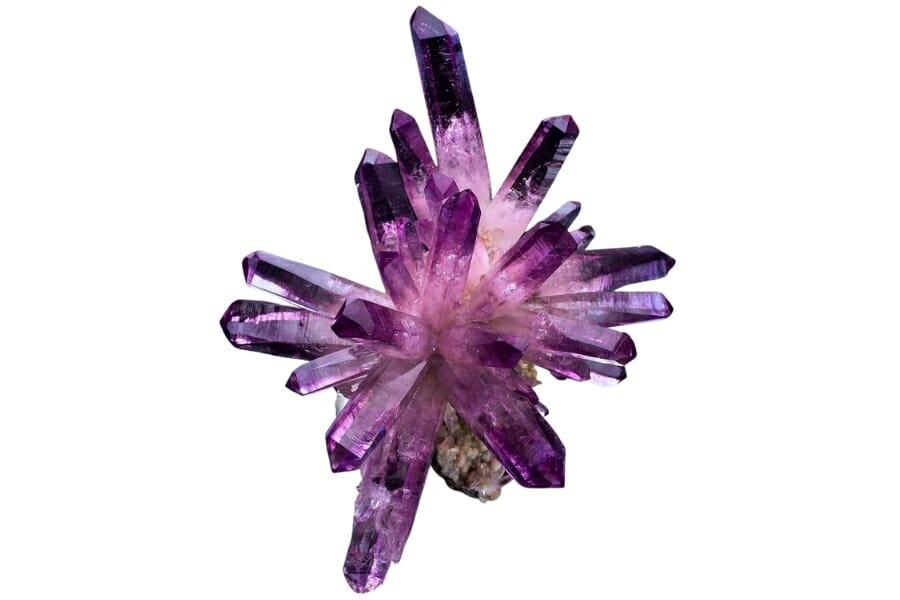Pennsylvania is brimming with a dazzling array of rocks, minerals, gems, and crystals that can satisfy any rockhound! Imagine yourself uncovering a sparkling crystal in the ridges of the Appalachian Mountains or spotting valuable rocks in the Delaware River.
From the anthracite coal found in the Northeast to the trilobite fossils unearthed in Montgomery County, our state is a treasure trove of geological gems. Whether you’re an expert rockhound or simply someone who appreciates the earth’s natural artistry, Pennsylvania’s rich geology is sure to captivate your imagination.
This fascinating journey of discovery is waiting for you and we’ll guide you throughout your exploration in this article. Get ready to explore and enjoy the rock-solid beauty of Pennsylvania!
A List of The Common Rocks, Stones, and Minerals Found in Pennsylvania
With Pennsylvania’s rich geological diversity, it’s no surprise that our state abounds in different natural treasures. If you’re on a quest to uncover them, make sure you check out our comprehensive guides that will help you find them:
Pennsylvania Rock, Mineral, and Gem
First off, here are our state’s flagship natural treasures.
| Pennsylvania State Rock | Anthracite (Unofficial) |
| Pennsylvania State Mineral | Celestine |
| Pennsylvania State Gem | Amethyst |
Before heading out to your exploration, it’s important to familiarize yourself with our state’s policies on collecting guidelines by visiting the official website of the Pennsylvania Department of Environmental Protection (PADEP).
Always Confirm Access and Collection Rules!
Before heading out to any of the locations on our list you need to confirm access requirements and collection rules for both public and private locations directly with the location. We haven’t personally verified every location and the access requirements and collection rules often change without notice.
Many of the locations we mention will not allow collecting but are still great places for those who love to find beautiful rocks and minerals in the wild without keeping them. We also can’t guarantee you will find anything in these locations since they are constantly changing.
Always get updated information directly from the source ahead of time to ensure responsible rockhounding. If you want even more current options it’s always a good idea to contact local rock and mineral clubs and groups
Celestine
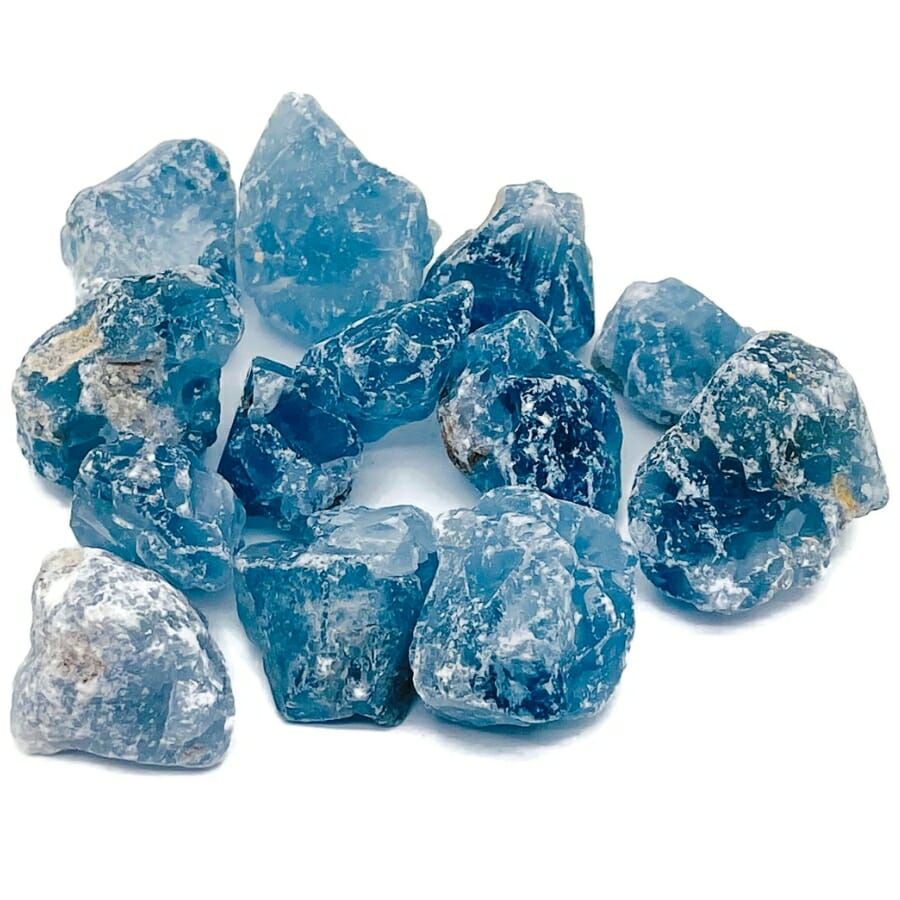
Celestine, also known as celestite, is a spectacular mineral, cherished by many for its heavenly blue color. It’s usually formed in sedimentary rocks, particularly limestone and dolomite, or in evaporative deposits. Over thousands of years, as water with strontium and sulfate seeps into the ground, the celestine starts to grow.
Our state has its own version of celestine that showcases amazing shades of blue, white, or colorless. What makes it even more special is that each crystal can look like a perfect prism or a flat tabular shape, with striations running parallel to its length. That’s why it’s Pennsylvania’s official state mineral!
Beyond its beauty, celestine is also a vital source of strontium, an element used in making glass for color television picture tubes and in fireworks for a brilliant red color. And for gemstone enthusiasts, polished pieces of this mineral are just breathtaking! So next time you come across a celestine specimen, remember: you’re holding a piece of Pennsylvania’s geological artistry that’s both incredibly useful and extraordinarily beautiful.
Where you can find Celestine in Pennsylvania
You can find gem-quality Celestine if you explore Meckley’s Quarry near Mandata.
Chert
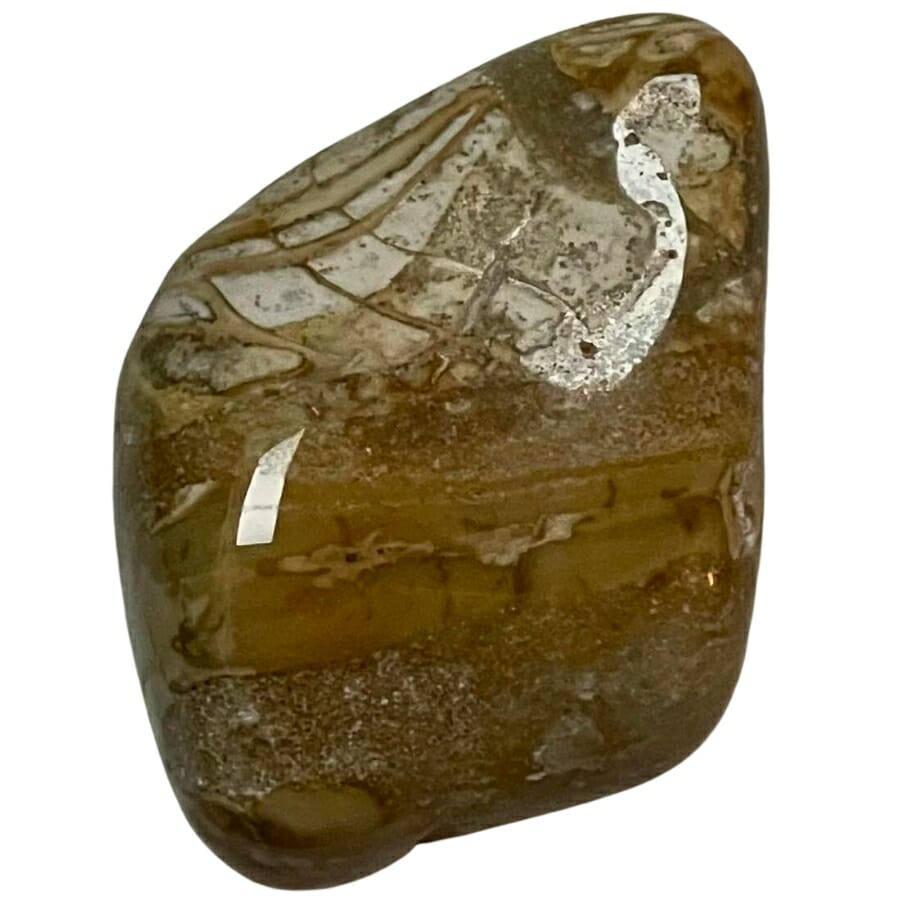
Chert is a rock that’s made up of tiny crystals of quartz, also known as silicon dioxide, that you’d need a microscope to see.
This rock usually forms in ocean environments from the remains of tiny sea creatures called diatoms. When diatoms die, they sink to the ocean floor and their remains pile up. Over thousands of years, this pile gets squished and heated up, which becomes chert.
Chert is valuable for its many uses. Native Americans treasured it because it can be chipped into sharp points for arrows and spearheads. It’s also been used in fire-starting as it creates sparks when struck by steel. Beyond that, collectors appreciate chert for its unique colors and textures.
Where you can find Chert in Pennsylvania
You can find chert in several specific areas in our state, including:
- Area washes, fields, and gravels of Allentown,
- Fields and gravels of Waterside and Claysburg
- Stream gravels and fields to the northwest of Philadelphia
Galena
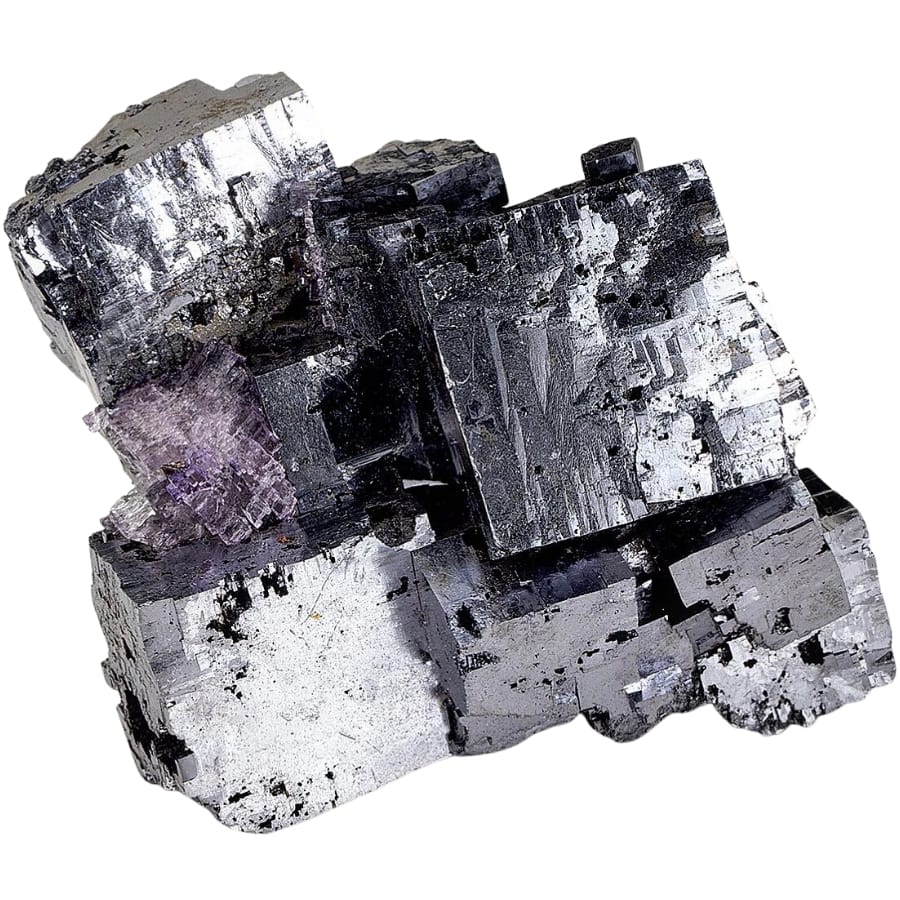
Recognized for its metallic luster and cube-like crystal structures, galena is a sight to behold. It usually forms in areas with lots of limestone or other sedimentary rocks. As hot fluids from deep within the Earth’s crust rise and mix with these rocks, the cool temperatures cause lead and sulfur to combine and create galena.
The galena found in Pennsylvania are found nestled in limestone or dolomite. It’s often silvery-gray or lead-gray, and its interesting cube-shaped crystals are always a fun surprise when found in the rocks!
Galena is the most important ore of lead, used in car batteries, protective shields for X-ray machines, and in the production of ammunition. It’s also a significant source of silver, as it sometimes contains small amounts of this precious metal. And if you’re a collector, its unique crystal shapes and shiny metallic luster will surely hook you.
Where you can find Galena in Pennsylvania
If you explore the Gravel Bar Hollow and Brookdale Mine, you can find specimens of Galena.
Chlorite
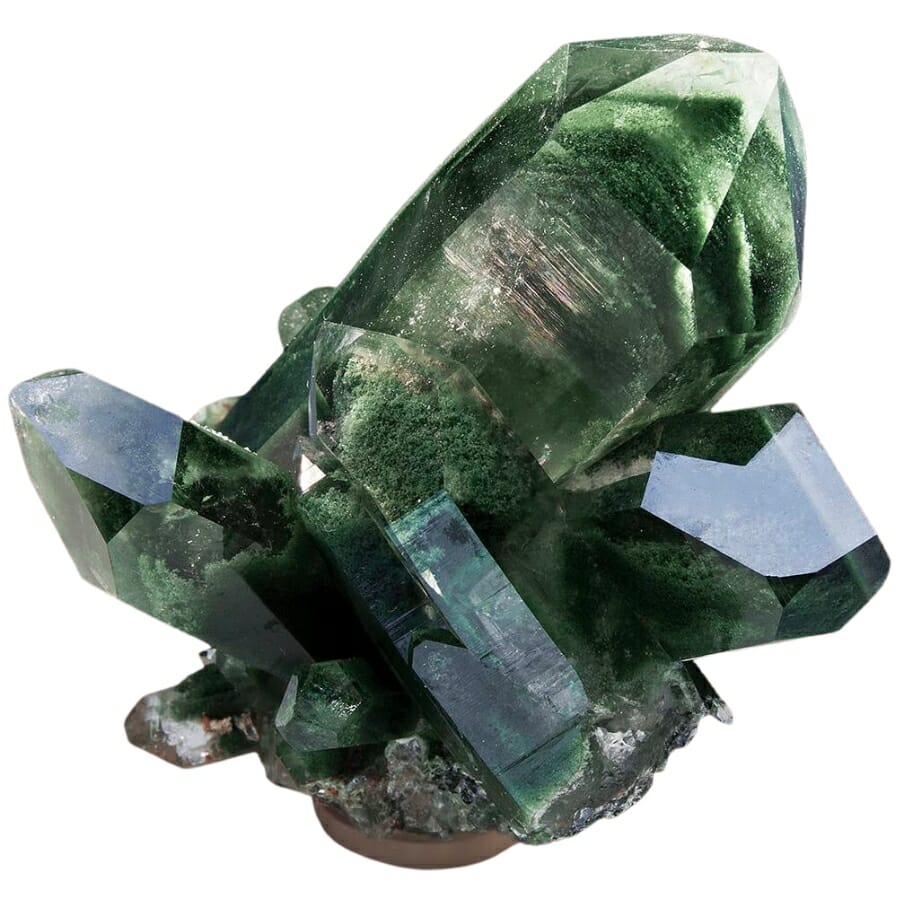
Chlorite is known for its beautiful green color, which makes it look like tiny pieces of leafy plants. It often shows up during the alteration of other minerals like mica and amphibole. This means that when heat and pressure change these original minerals, chlorite starts to form.
Chlorite is often found in metamorphic rocks, like schist and gneiss. They lend these rocks their green color and make them really special. You might find also find this mineral in different shades of green: from light apple green to deep forest green.
As for its value, chlorite is an important part of the Earth’s geological processes, marking where significant changes have happened in a rock’s life. Also, its lovely green color makes it a favorite among mineral collectors.
Where you can find Chlorite in Pennsylvania
There are a handful of places where Chlorite occurs in our state, such as:
- Mt. Pisgah
- Sherman Valley
- Old mining dumps in Cornwall
Magnetite
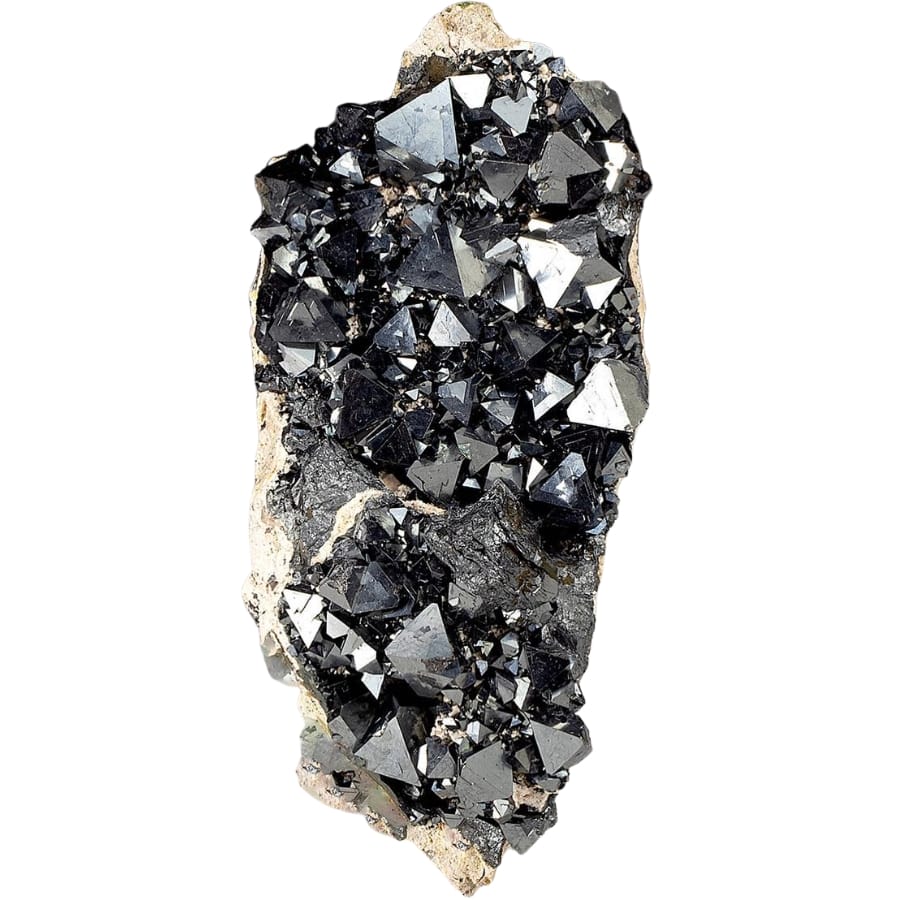
Magnetite, just as its name suggests, is a kind of mineral that’s magnetic. This dark, shiny wonder forms when molten rock or magma cools down and solidifies. It can also be created when other iron-rich minerals are altered by water, heat, and pressure deep inside the Earth.
Magnetite is one of the most important ores of iron, which means it’s a key ingredient in creating steel. Plus, because it’s magnetic, it’s used in many electronic and industrial applications.
Pennsylvania magnetite is often found within gneiss and schist, which are types of metamorphic rocks. Sometimes, you might come across magnetite that is dark gray or black, and, if you’re lucky, you might find some that have formed into shiny, octahedral (eight-faced) crystals!
Where you can find Magnetite in Pennsylvania
If you want to find magnetite here, you can visit the following sites:
- Quarries in Gettysburg
- Mines near French Creek
- Quarries and dumps in Girty and Lebanon County
Anthracite
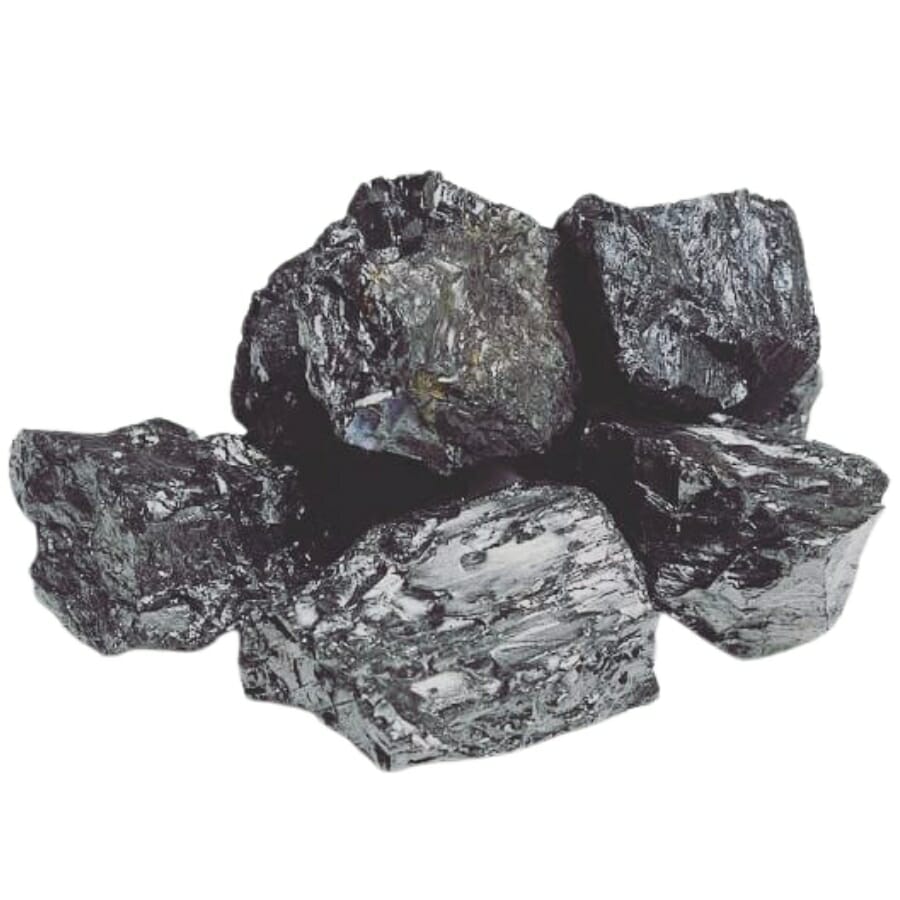
Anthracite is an amazing type of coal! This black and shiny rock forms from plant material that was buried millions of years ago. With heat and pressure, it transforms into peat, then lignite, then bituminous coal, and finally anthracite!
As hard coal, anthracite burns hotter and cleaner than other types of coal, which makes it a valuable resource for heating homes and industrial processes.
Pennsylvania has a deep connection with anthracite. In fact, most of the anthracite in the country is right here! This is also why there is legislation filed to designate it as our state’s official state rock.
Where you can find Anthracite in Pennsylvania
Exploring the following areas in our state will give you a chance to find anthracite:
- Nesquehoning Coal Mine
- Sullivan Trail Coal Company Mine
- Kuperavage Mine
The Gemstones Found In Pennsylvania
Pennsylvania is not only rich in rocks and minerals— we have plenty of gems just waiting to be discovered! If you want a comprehensive guide on where to find these amazing wonders within our state, check out the following:
Calcite
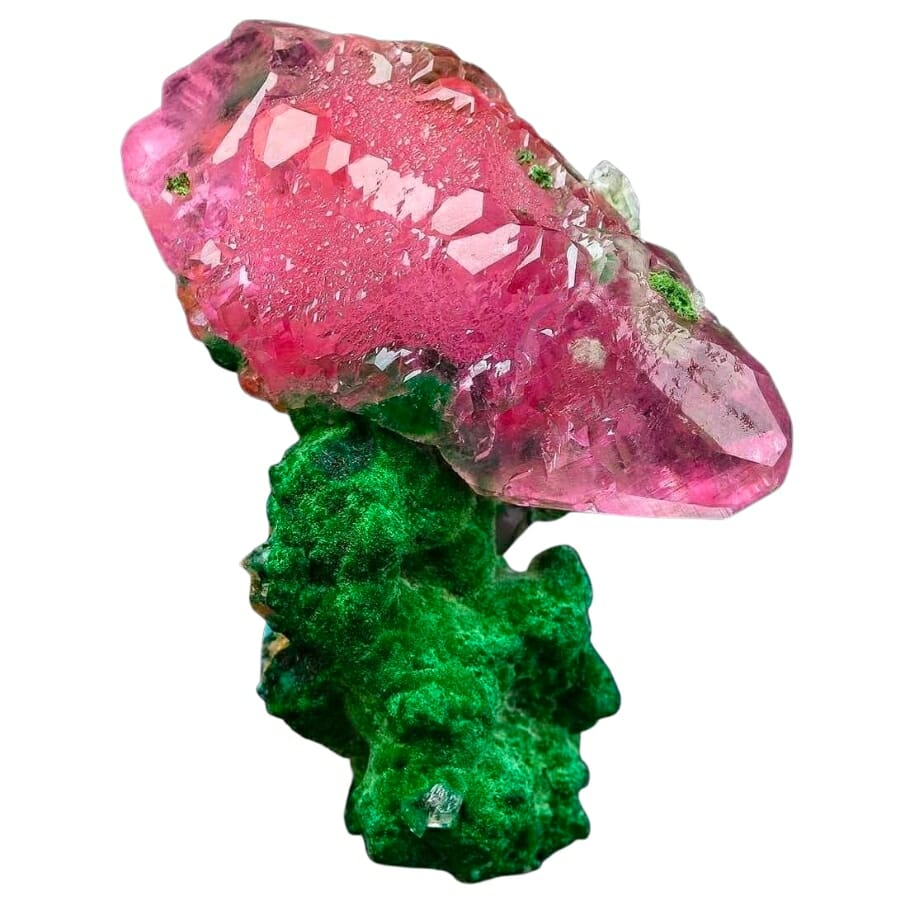
Calcite is made from calcium carbonate, which forms in many places. Over time, these shells get compacted into sedimentary rock like limestone. Calcite can also form from hot, mineral-rich water that seeps into cracks in the rock and then slowly evaporates, leaving behind beautiful crystals.
Besides its rainbow of colors, calcite can split light into two rays, a property known as double refraction. That means when you look through a clear piece of calcite, you’ll see two of everything! Plus, as a gem, it can be carved or polished into beautiful decorative items and jewelry. This also contributes to calcite’s value.
The calcite found in Pennsylvania is often colorless or white, but it can also be found in shades of yellow, red, pink, green, blue, and more. And let’s not forget its cool crystal shapes— it often forms rhombohedra, which look like squished cubes!
Mistaking calcite for other rocks and minerals is common, but fear not! Our user-friendly guides are designed to help you quickly differentiate calcite from its look-alikes:
Where you can find Calcite in Pennsylvania
You can find Calcite in the following spots:
- Sherman Valley
- Morrisons Cove
- Union Furnace area quarries
Amethyst
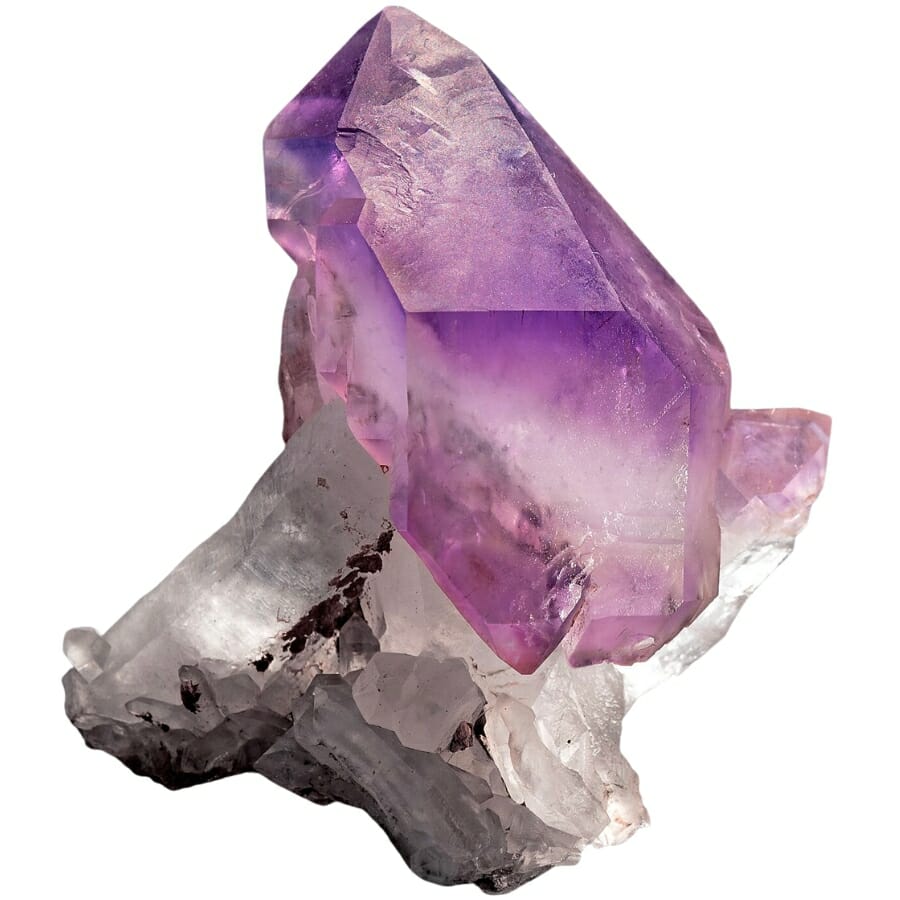
Amethyst is a type of quartz, and its unique purple color comes from iron and other trace elements inside the crystal. These beauties often form in volcanic rocks, especially in hollow cavities called geodes. As hot, mineral-rich water seeps into these geodes and cools down, the amethyst starts to grow!
Amethyst is not just gorgeous; it’s also been valued for thousands of years as a gemstone. It’s often used in jewelry, from rings to necklaces, because of its hardness and beautiful purple tones. Some people also believe it has calming properties. Its beauty and uses have contributed a lot to amethyst’s price and value.
Amethyst is Pennsylvania’s official gemstone and for good reason! The specimens you’ll find here can range from a light lavender to a deep, royal purple that forms in lovely crystal shapes that are simply irresistible!
Where you can find Amethyst in Pennsylvania
You may visit the following sites to look for captivating amethysts:
- Brandywine Creek
- Chester Creek
- Crum Creek
Jasper
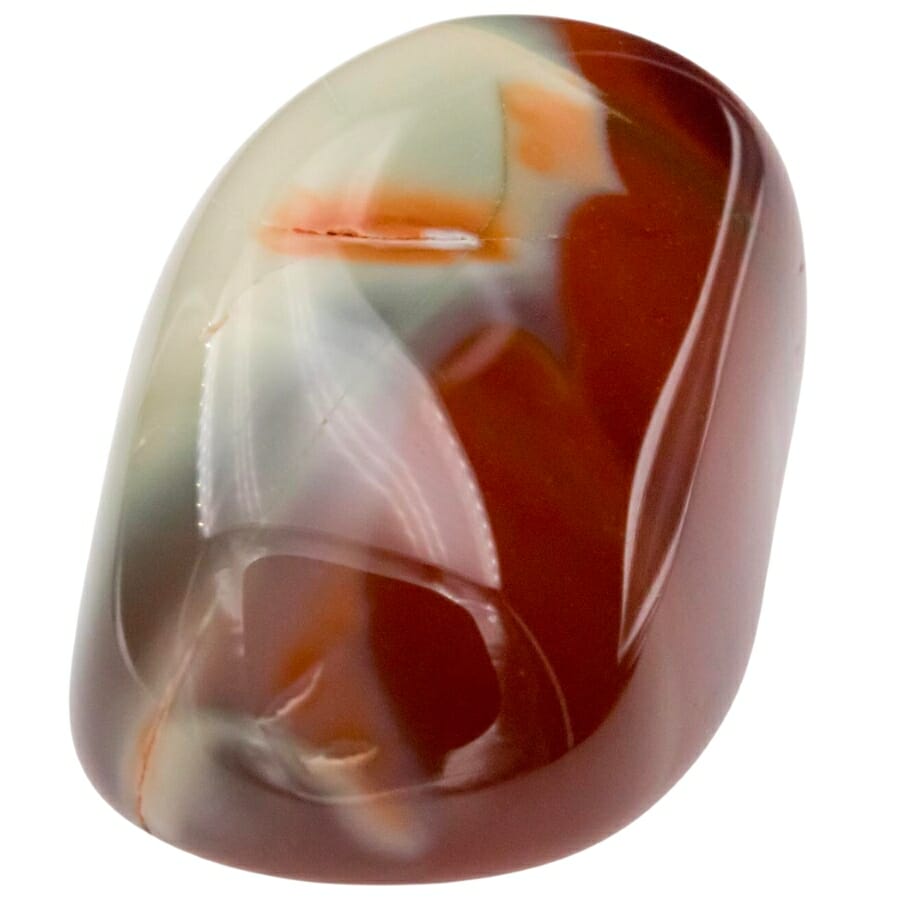
Jasper is a fascinating gemstone with a rainbow of colors. It’s a type of chalcedony that forms from ancient mud or volcanic ash that hardens over time into rock. As groundwater rich in silica seeps through, it transforms the rock into jasper.
You might be wondering how much jasper is worth, and we’ve got you covered on that. Overall, it’s pretty valuable as it’s been used for thousands of years to make decorative items and tools. Its beautiful colors and patterns also make it a favorite for jewelry and ornaments.
Red, yellow, green, brown, and even blue jasper can be found in our state, each with its own unique swirls and bands of color.
Where you can find Jasper in Pennsylvania
Jasper is abundant in our state and you can find them in the following areas:
- Redbank Creek
- Caledonia State Park
- Area washes, gravels, and exposures in Derry
Garnet
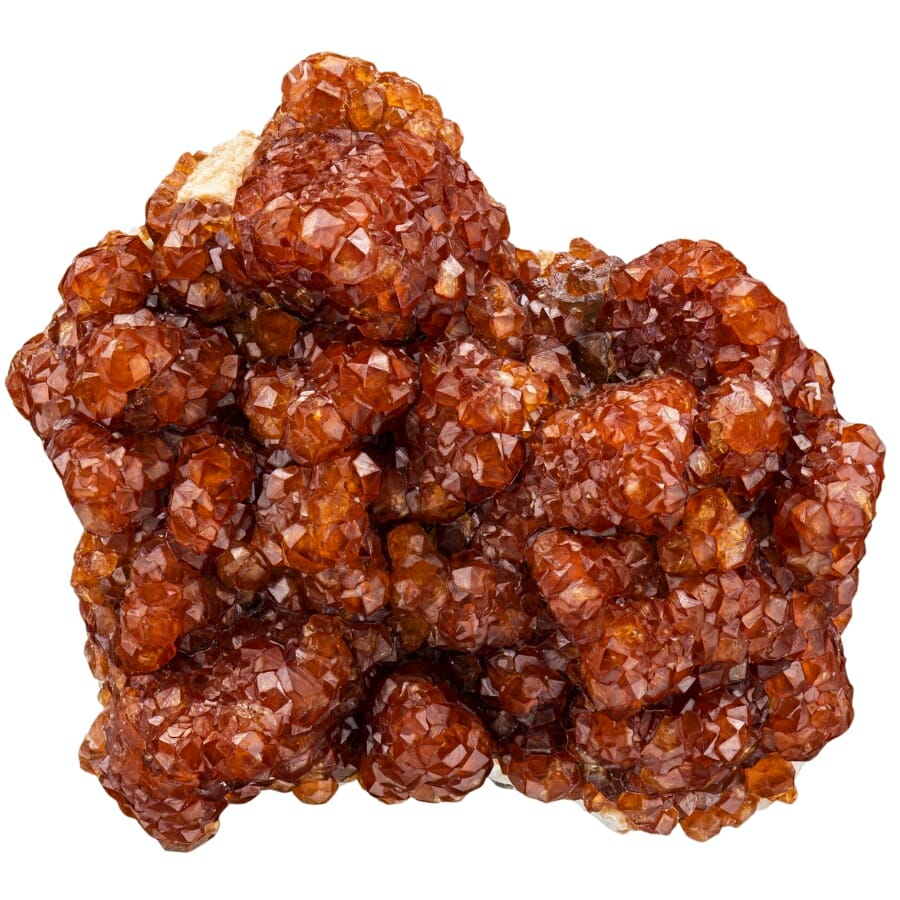
Garnets form deep in the Earth’s crust under high pressure and heat. As molten rock cools, the garnet crystals start to grow.
For thousands of years, garnet’s value as a gemstone is evident in its use. Its hardness makes it perfect for carving into beautiful jewelry. Plus, its wide range of colors means there’s a garnet for everyone’s taste!
Garnet is also sometimes used as an abrasive material due to its hardness. On top of that, rockhounds and collectors love garnet for its perfect crystal shapes and rich colors.
Where you can find Garnet in Pennsylvania
You can find Garnet on the following sites:
- Fox Hill
- Nottingham Park
- East Branch Naamanms Creek
Cerussite
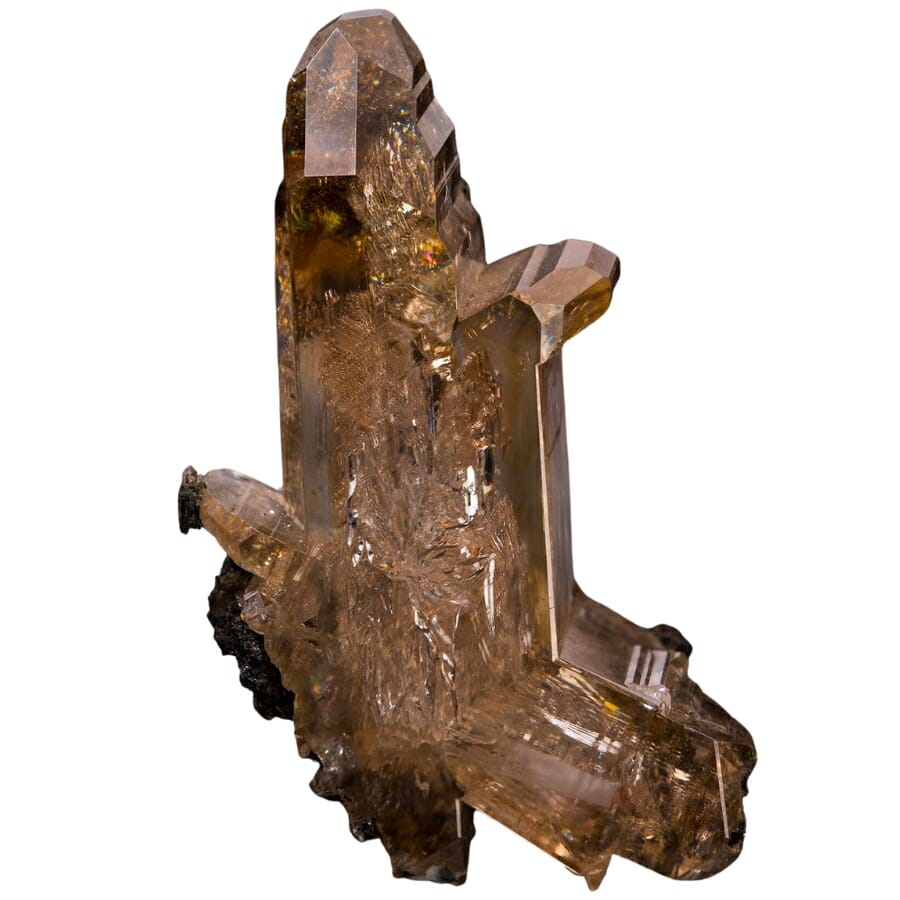
Cerussite is a gemstone made up of lead carbonate. One of its most famous properties is its incredible sparkle, thanks to its high refractive index. It’s so sparkly, in fact, that it’s sometimes called “light of the desert”!
Besides its sparkle, cerussite is also a favorite among mineral collectors because of its fascinating crystal forms and its role in our environment, as it helps scientists understand how lead moves through the Earth.
This gemstone is often colorless or white but sometimes takes on a gray or brown tint. It can also form in all sorts of cool patterns, from elongated prisms to star-like clusters!
Where you can find Cerussite in Pennsylvania
We recommend exploring the Carpenter Mine and Brookdale Mine for amazing specimens of Cerussite.
Barite
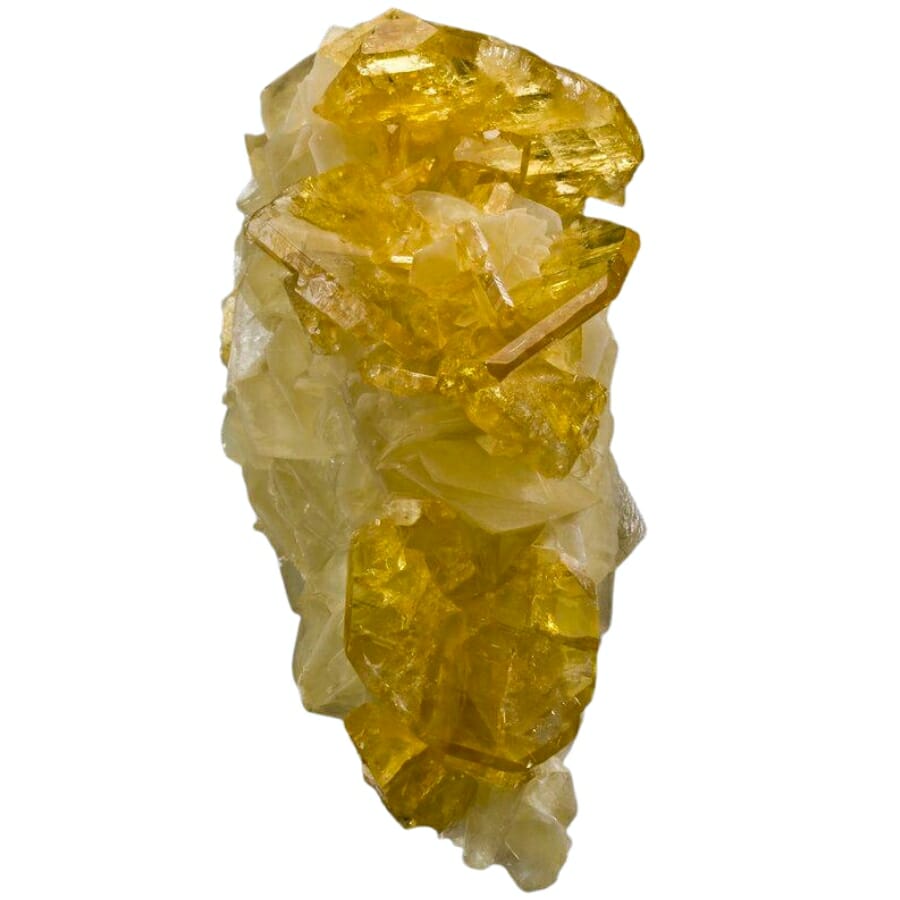
Barite is a gem made up of barium sulfate. It forms in a variety of geological environments, often in hot springs or in cavities of sedimentary rocks, where it grows into impressive crystals.
This gem’s high density makes it distinct, so when you hold a piece of barite, it feels surprisingly heavy for its size! It’s also used in a variety of industries: from oil drilling to medicine, where it’s used as a contrast agent in certain medical imaging tests. Its clear or lightly-colored crystals are also prized by gem collectors worldwide.
The specimens of barite that you’ll find in Pennsylvania are often colorless or white, but yellow, blue, green, and other colored ones. The shapes of its crystals can be just as varied, from tabular and prismatic to rosette-like clusters.
Where you can find Barite in Pennsylvania
Barite can be found in the following specific areas of our state:
- Road cuts and gravels of Etna
- Gravel Bar Hollow
- Aughwick Creek
The Crystals Found In Pennsylvania
Stunning Pennsylvania crystals, anyone? If you’re looking for these wonders, fret not, because we’ve prepared a comprehensive guide that you can use:
Now, let’s delve into some of the common crystals that you’ll find here:
Azurite
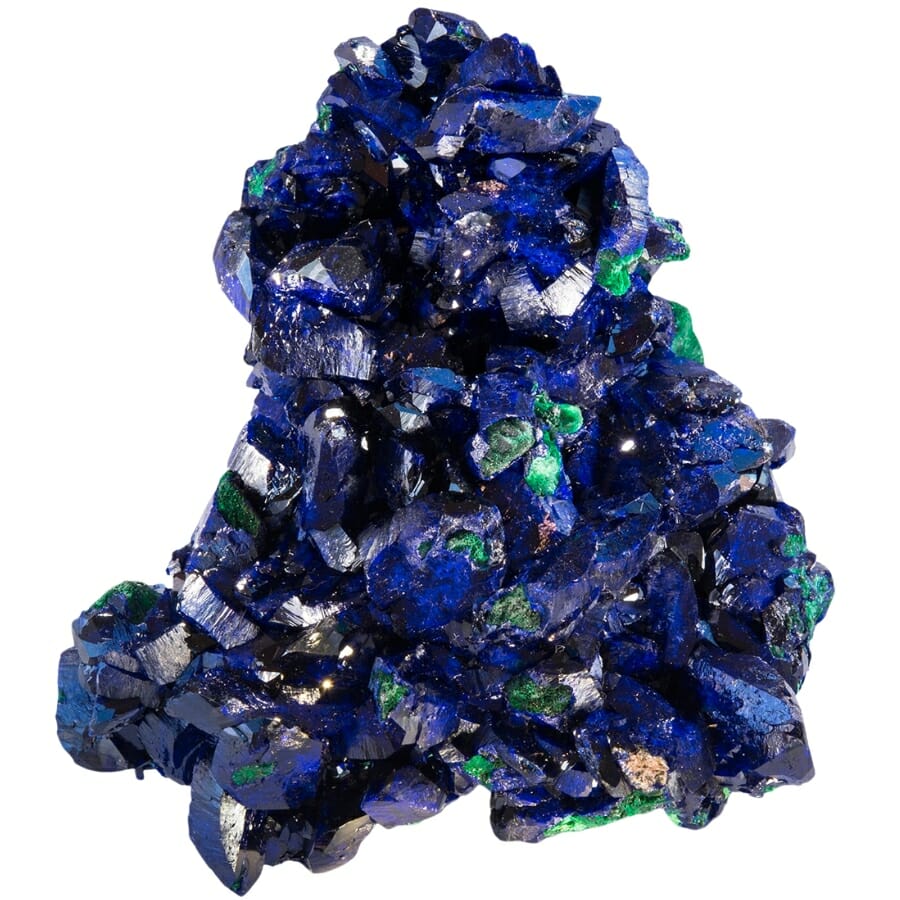
Azurite is a crystal that’s as fascinating as it is beautiful! It forms when copper ores weather or break down over time. Its bright blue color is a sure sign that copper is present.
For thousands of years, Azurite has been used as a blue pigment because its color is so intense. It was even used in wall paintings in Ancient Egypt! On top of that, its striking blue color and unique crystal forms make it a standout. It’s also important to scientists because it helps us understand how copper moves through the Earth.
The azurite you may find in our state is usually a deep, dazzling blue and can even have a bit of green from the presence of malachite, another copper mineral.
Where you can find Azurite in Pennsylvania
If you’re in search of Azurite, explore the following spots here:
- Kunkeltown area stream gravels
- Adams County mines and quarries
- Rossville road cut
Quartz
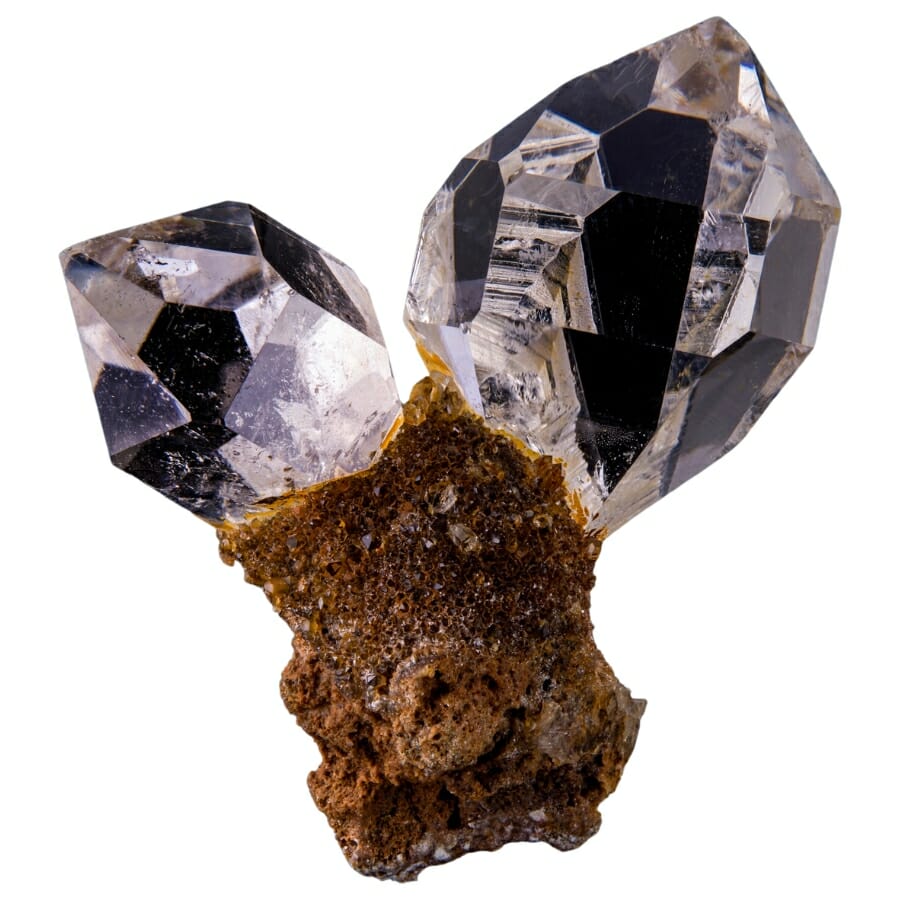
Quartz is one of the most common and varied crystals on Earth. It forms when silicon and oxygen combine in just the right way. This happens in many places, from deep within the Earth’s crust to the surfaces of soils and rocks.
If you’re wondering about quartz’ value, its amazing versatility has definitely boosted it. People have been using quartz for thousands of years to make tools, jewelry, and even early forms of glass. Nowadays, it’s also used in technology, like in watches and electronics, because it can generate an electric charge under pressure.
Quartz is also a favorite among rock collectors. Its wide range of colors and crystal shapes keep it interesting. Here in Pennsylvania, quartz comes in all kinds of forms and colors: there’s clear quartz, milky quartz, and even beautiful smoky quartz.
Where you can find Quartz in Pennsylvania
You can find quartz if you search through the following sites:
- Easton area quarries
- Stroudsburg area gravels and exposures
- ‘The Echo’ coal mines
Fluorite
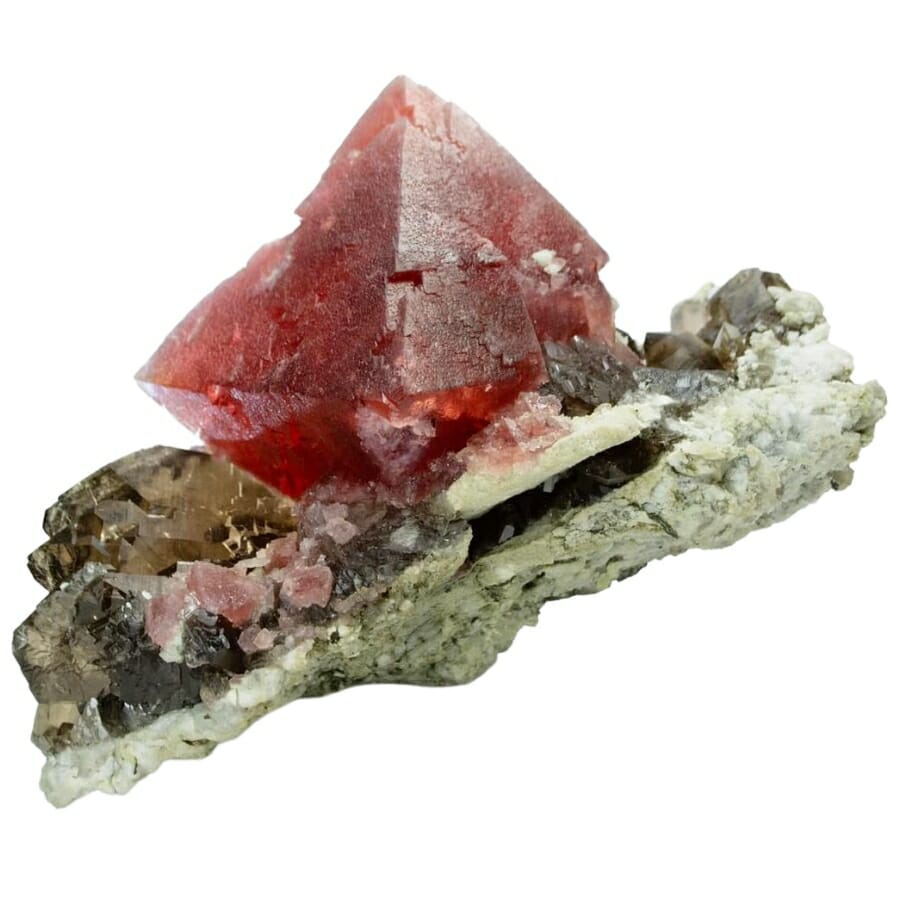
Fluorite is a crystal made from calcium fluoride. It forms in places where hot, mineral-rich water moves through rocks, leaving behind colorful crystals as it cools. Under ultraviolet light, fluorite also glows!
It’s been used for centuries in jewelry and decorative objects because of its lovely colors and perfect cleavage. It’s also used in making a wide range of products, from steel and aluminum to glass and enamel. On top of it all, collectors love fluorite for its variety of colors and crystal shapes.
If you want to dive deeper into fluorite’s price and value, check out our article on that.
Where you can find Fluorite in Pennsylvania
To find fluorite, you can explore many places here, such as:
- Monroe County quarries
- Boiling Springs in White Rocks
- Brookdale Mine
Hematite
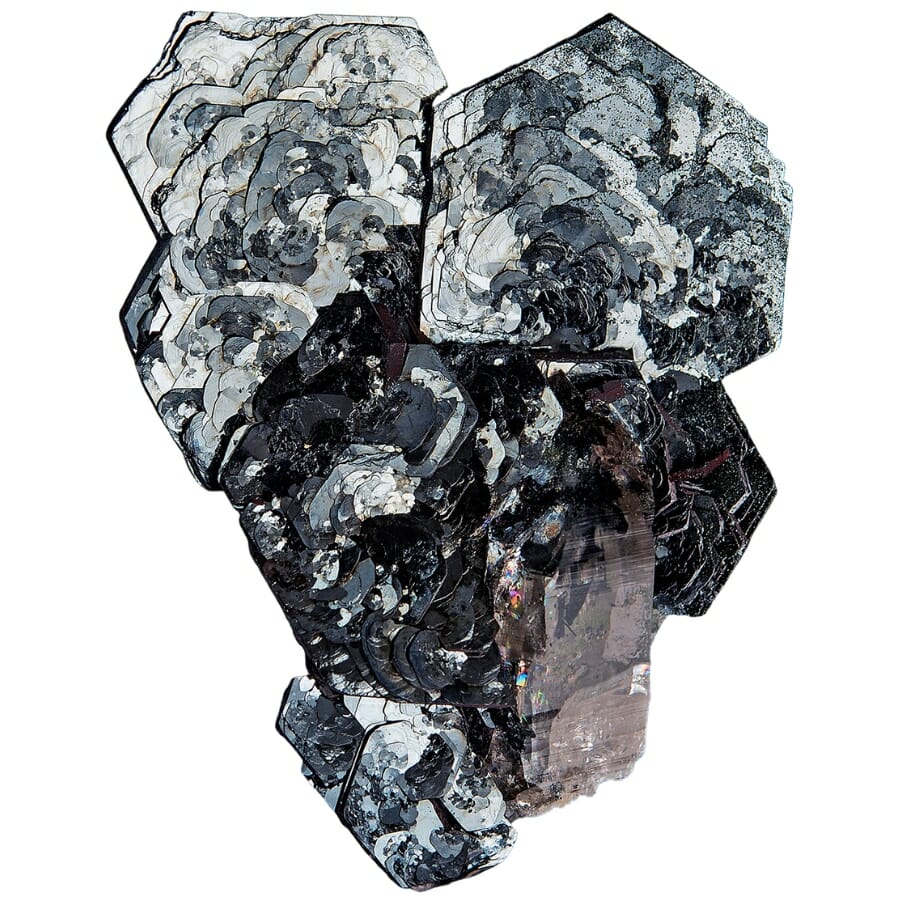
Hematite is an iron oxide that forms in different environments, often in places where water once existed. This can be deep underground or even on the surface of Mars!
So, why is hematite awesome? For starters, it’s been used since ancient times for its rich, red pigment. Even today, it’s used to color everything from paint to cosmetics. It’s also a key source of iron for making steel. Truly, hematite’s value goes beyond its aesthetics!
The hematite you’ll find in our state is often a shiny, metallic gray, but it can also be reddish-brown. It’s found in a variety of forms, from compact masses to tabular and rosette-like crystals.
Where you can find Hematite in Pennsylvania
Hematite is found in the following areas here:
- Area mines near French Creek
- Little Rocky Ridge
- Area quarries of Lancaster, Blue Ball, and Brownstown
Chalcedony
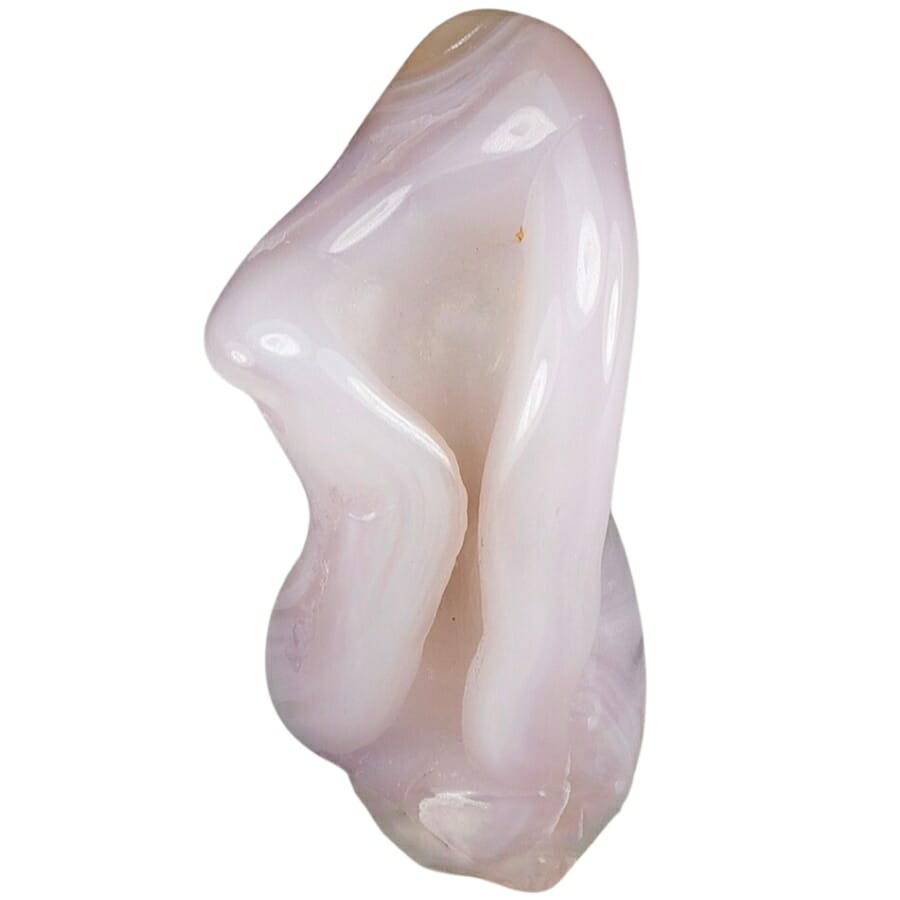
Chalcedony is a type of quartz that forms in volcanic rock cavities. Here, super-hot water rich in silica cools down and solidifies into this unique mineral.
Pennsylvania is no stranger to chalcedony! It’s often found in many colors and forms, but the most common is a milky white to gray, often with a waxy luster.
How much is chalcedony worth and just how valuable it is, you might ask? Well, this crystal has been used for thousands of years for tool-making and artistic carving. Today, it’s loved for its vibrant colors and patterns and is often used in jewelry.
Collectors adore chalcedony, too! Its wide range of colors and the beautiful, intricate patterns within the stone keep things exciting. Plus, it can tell us a lot about the geological conditions under which it formed.
Where you can find Chalcedony in Pennsylvania
You can uncover Chalcedony in the different nooks and crannies of our state, especially in:
- Alsace Township
- Quarries along Schuylkill River
- Area fields and gravels of Waterside
Tourmaline
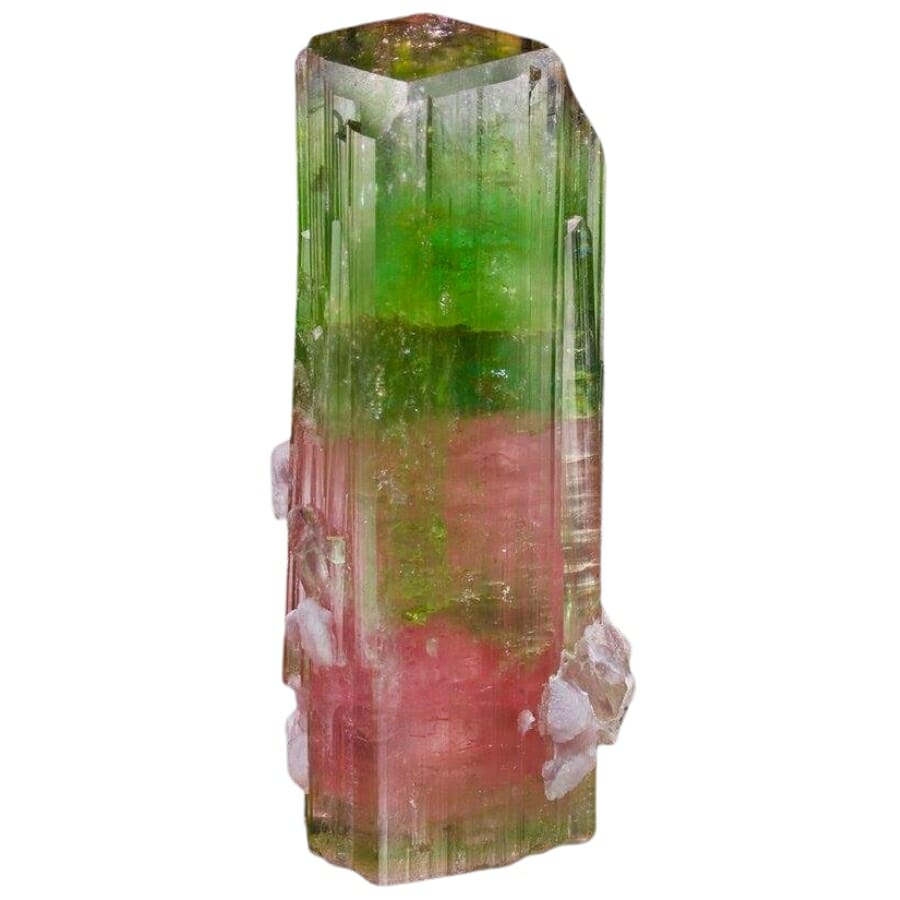
Tourmaline forms in places where hot, mineral-rich fluids move through cracks in rocks. As the fluid cools down, it leaves behind crystals in a variety of colors.
The great thing about tourmaline is that it’s one of the most versatile gemstones. With so many colors to choose from, it’s perfect for jewelry. It’s even used in some electrical devices because of its unique properties. Many people also believe it has positive energetic properties, ranging from protection to stress relief.
In Pennsylvania, there’s a rainbow of tourmaline. It can be found in shades of black, green, pink, blue, and sometimes even in a mix of colors in one single crystal!
Where you can find Tourmaline in Pennsylvania
You can find beautiful tourmaline crystals if you explore these sites:
- Nottingham Park
- White Rocks
- Sherman Valley
Pyrite
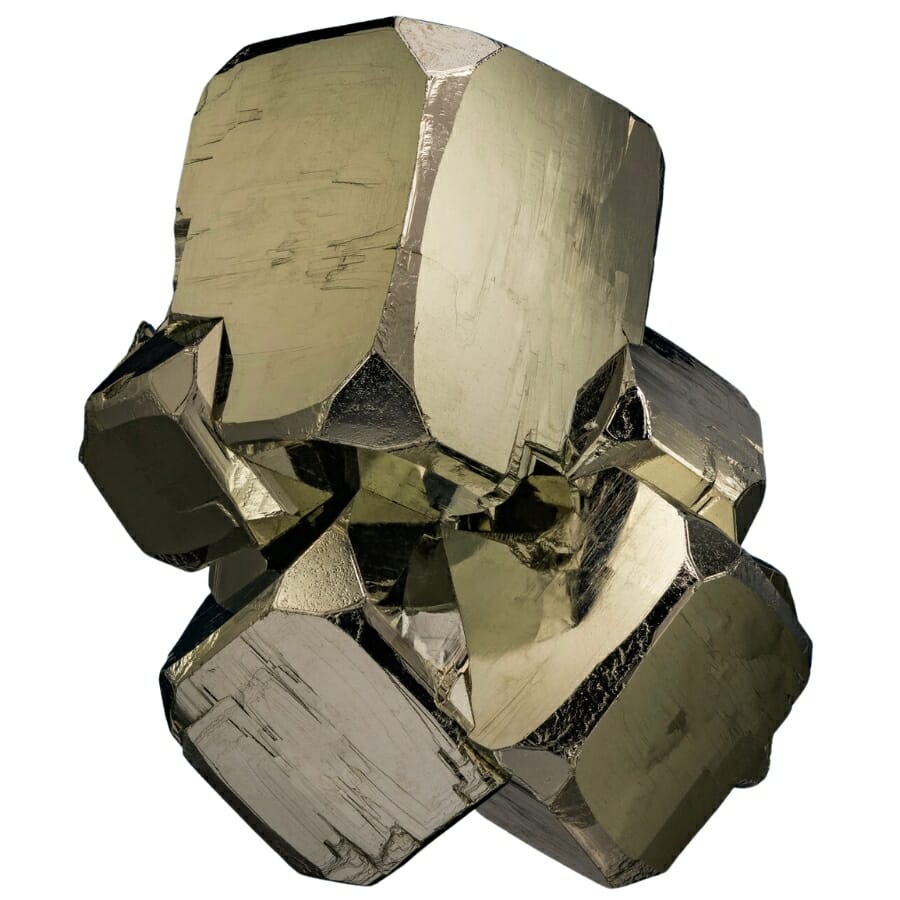
Pyrite forms in a variety of geological settings, from sedimentary layers to hydrothermal veins. Here, you can find pyrite aplenty! It’s often seen as shiny, metallic gold clusters, earning it the nickname “Fool’s Gold”. But don’t be fooled, this mineral is much more than a gold look-alike!
It’s been used throughout history in a variety of ways. Early humans used it to create sparks for fire, and it was once mined as a source of sulfur for making sulfuric acid. Its glittering surfaces and intricate crystal formations, often forming cubes or pyritohedrons, make it a real standout in any collection.
In the wellness world, pyrite is also beloved for its supposed energy-boosting and protective properties. Many people enjoy wearing it as jewelry or keeping it in their homes. If you’re curious about pyrite’s value and price, you can also read our article on that.
Where you can find Pyrite in Pennsylvania
Explore the following sites to find incredible pyrite specimens:
- Area coal mines in Schuylkill County
- Aughwick Creek
- Mt. Pisgah
The Most Valuable Rocks and Minerals in Pennsylvania
Aside from the different types of common rocks in Pennsylvania that we’ve discussed above, we also have a few valuable natural wonders that you should know about.
Sunstone
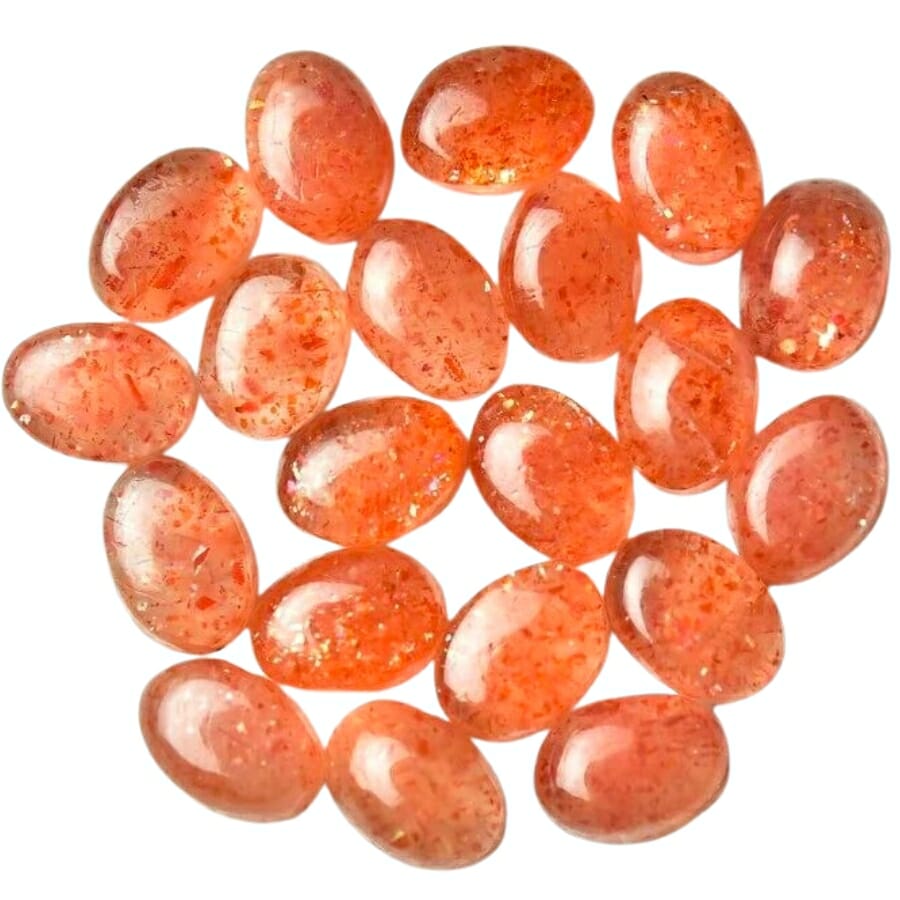
Sunstone, a real treasure to behold, is found in different rocks around the world. This remarkable gem dazzles us with its sparkling metallic glints, often compared to the warm, glowing light of the sun.
It gets its unique shimmer from the tiny reflective particles inside it, usually made of copper or hematite. This effect is called aventurescence, giving the sunstone its spectacular shine.
Besides its visual appeal, sunstone’s value can be attributed to its relative rarity, especially in large, gem-quality specimens. Jewelry makers adore it for its unique play of light, and it’s often used in rings, pendants, and other ornamental pieces.
Where you can find Sunstone in Pennsylvania
You can find sunstone in the area outcrops and gravels of Feasterville and Blue Hill.
Moonstone
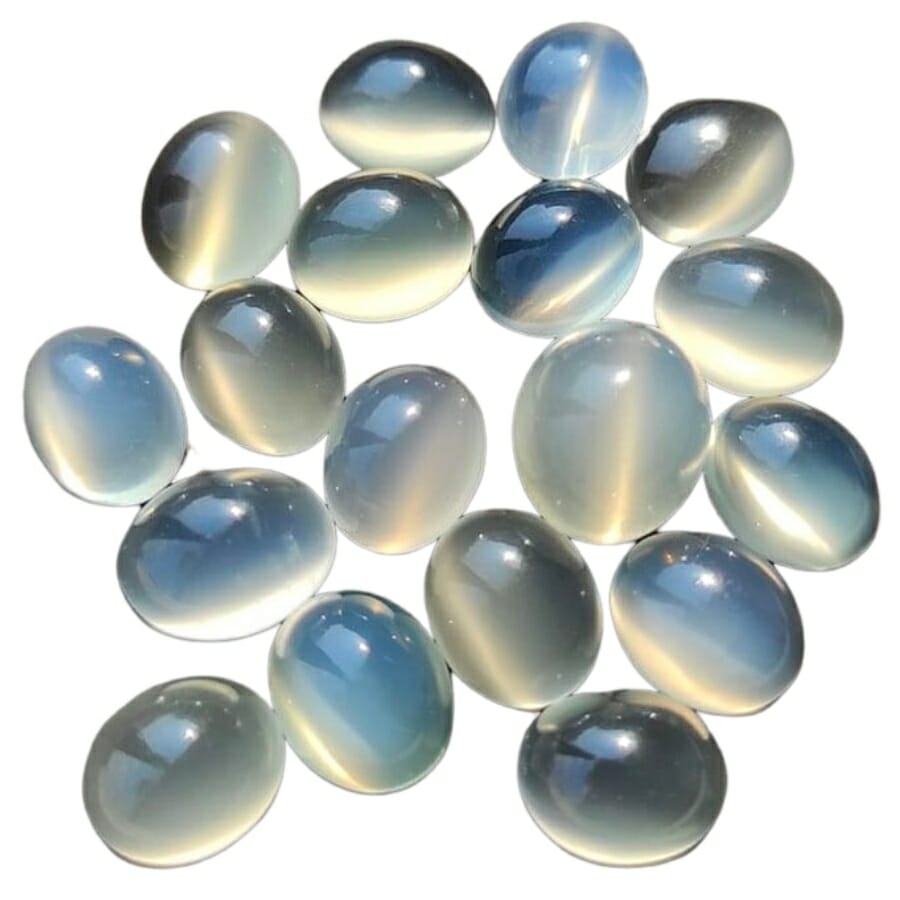
Just as the moon lights up the night sky, moonstone catches your eye with its mesmerizing sheen, a phenomenon called adularescence. This effect, similar to the moon’s soft glow, is created by the scattering of light within the layers of the gemstone.
The formation of moonstone is a long story of millions of years. It begins deep within the Earth, where intense heat and pressure lead to the growth of these alluring crystals. It’s a process that requires just the right conditions, making each moonstone a small geological marvel.
Beyond its visual allure, moonstone holds a special place in many cultures. It’s often associated with love, passion, and good fortune. Its unique appearance and cultural significance also make it highly sought after for jewelry and decorative pieces. To know more about moonstone’s value, check out our article.
Where you can find Moonstone in Pennsylvania
Explore the many old mining dumps in Cornwall to find specimens of moonstone here.
Prehnite
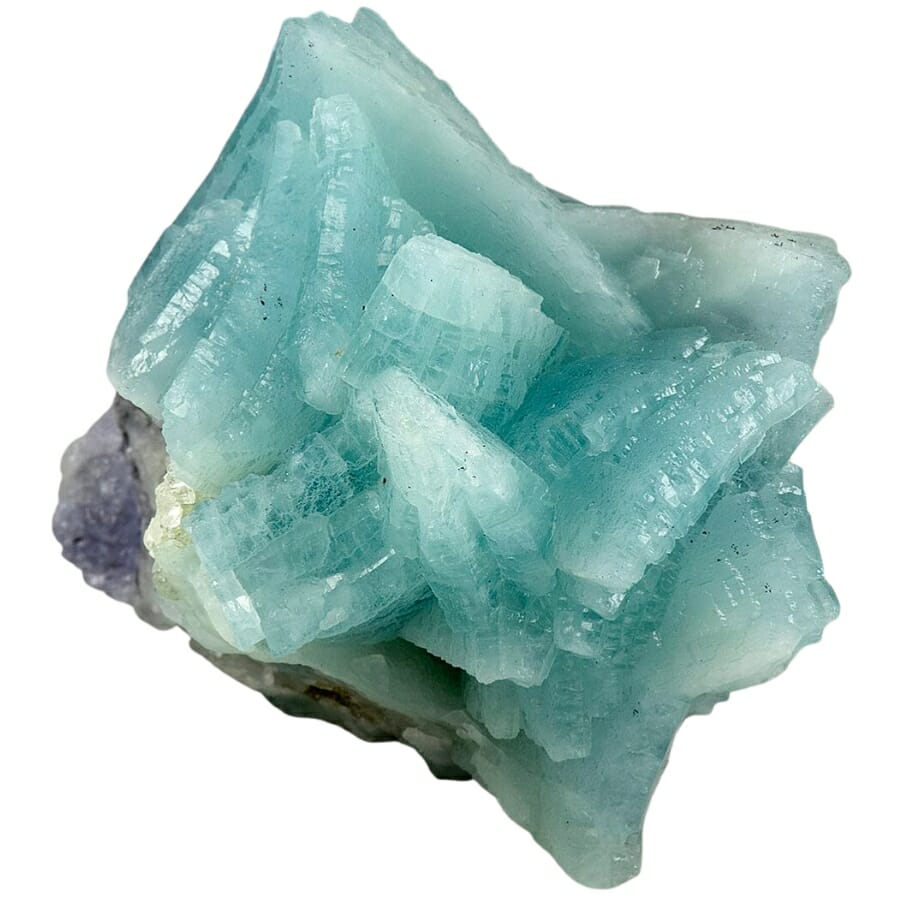
Prehnite is a beautiful crystal that’s sure to catch your eye with its lush, green color, reminiscent of a tranquil forest or cool sea. It’s part of the phyllosilicate mineral family, which, in simpler terms, means it’s formed from layers of silicate groups.
Prehnite’s value is not just about its soothing color. It’s a favorite among collectors and crystal enthusiasts because of its unique crystal structure, which can form globular or stalactitic formations. In some cultures, it’s even considered a stone of prophecy and spiritual growth.
Where you can find Prehnite in Pennsylvania
You can find Prehnite in the old mining dumps in Cornwall.
How to Identify The Rocks and Minerals You Find
Identifying rocks and minerals is a pretty tricky and oftentimes challenging endeavor. But you don’t necessarily have to be an expert to do this successfully. Below are some of the simple tests you can do to identify your specimen:
Closely observe the color of the specimen
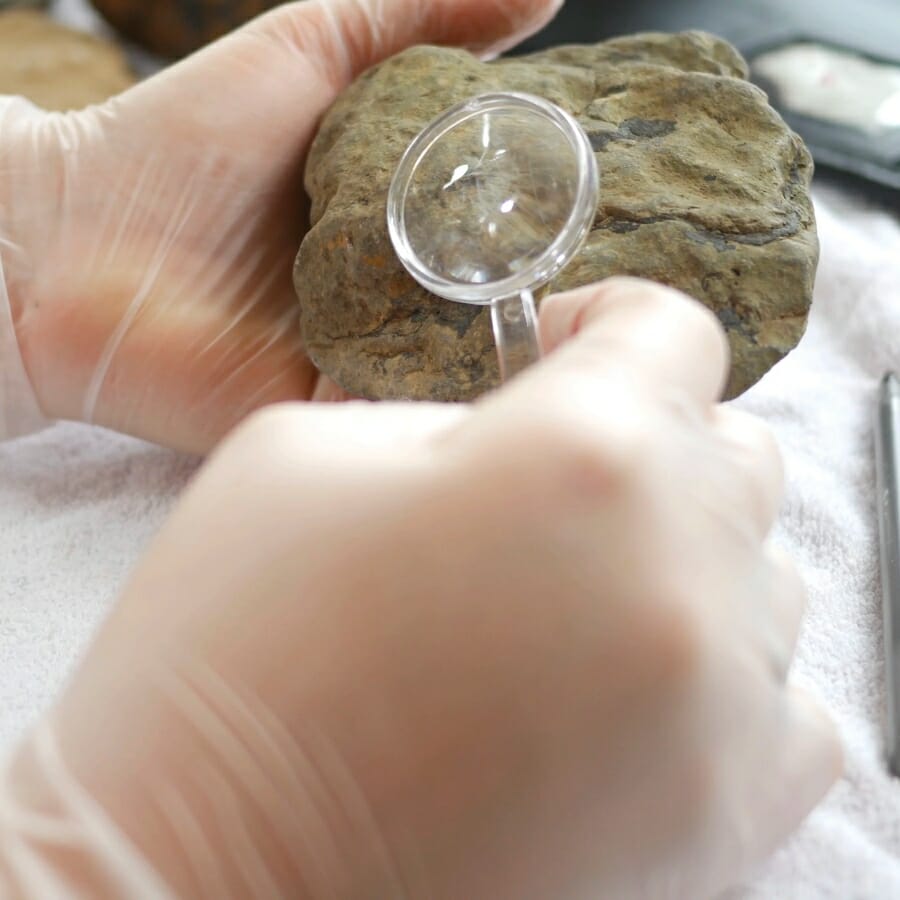
Colors are often the first clue when identifying rocks and minerals. But be aware, the color of a mineral can sometimes be misleading because of impurities or weathering. However, certain minerals like azurite with its stunning blue, or cinnabar with its unique red, have distinctive colors.
Conduct a simple streak test
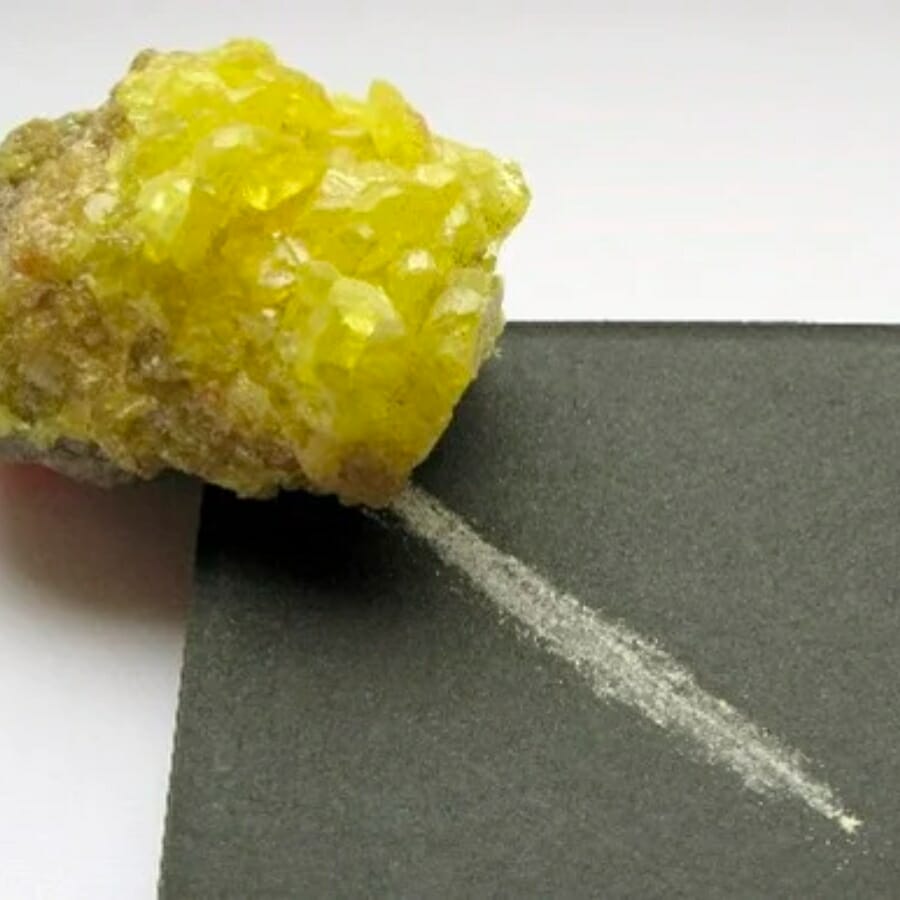
The ‘streak’ is the color of the powdered mineral that you can get by rubbing the specimen across an unglazed porcelain tile (called a streak plate). Different specimens leave differently-colored streaks.
For example, hematite, which is usually silver-grey, leaves a reddish streak, while emerald and jade both leave white streaks.
Do a scratch test to measure its hardness

Hardness is measured on the Mohs scale, ranging from 1 (talc) to 10 (diamond). You can do a basic hardness test at home using common objects.
For instance, if a specimen scratches a copper penny but not a glass plate, its hardness is between 3 and 5. From then, you can easily refer to the Mohs scale to see what specimens share the same hardness level.
Check the specimen’s luster
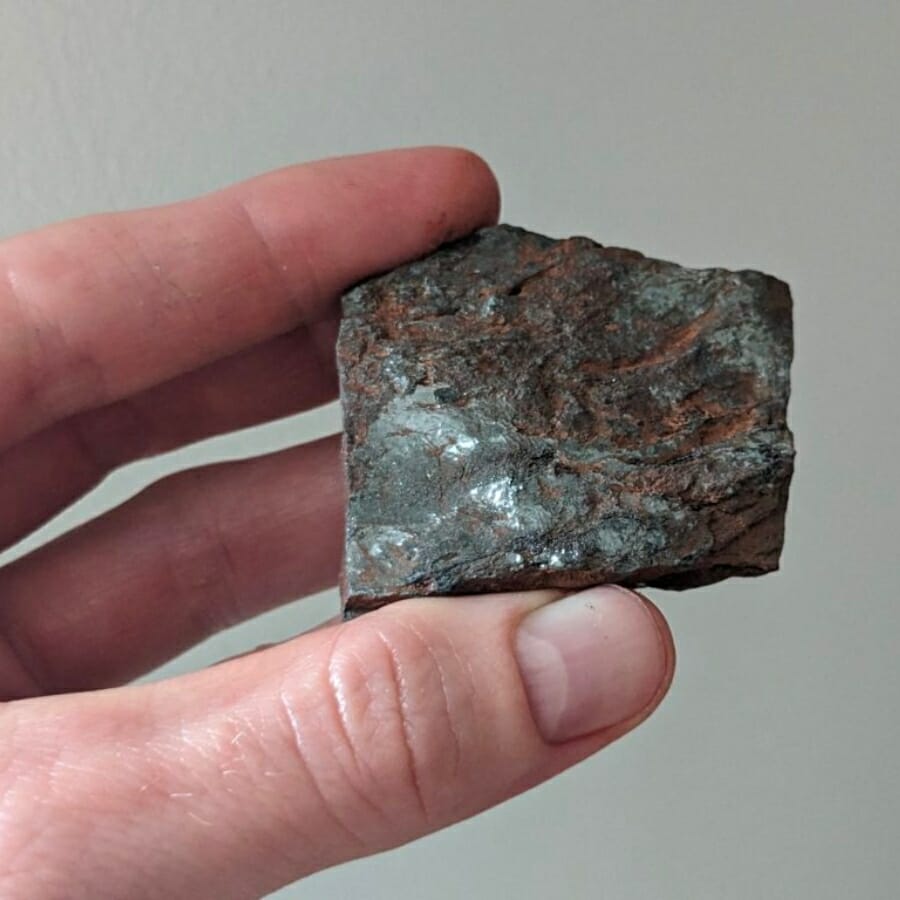
Luster is how a specimen reflects light. Is it shiny like metal or does it have a glassy glow? Maybe it’s dull or pearly?
Observing the luster can give you clues about your specimen. Metallic minerals, like pyrite, have a shiny, metal-like appearance, while quartz has a glassy luster.
Observe its crystal form and cleavage
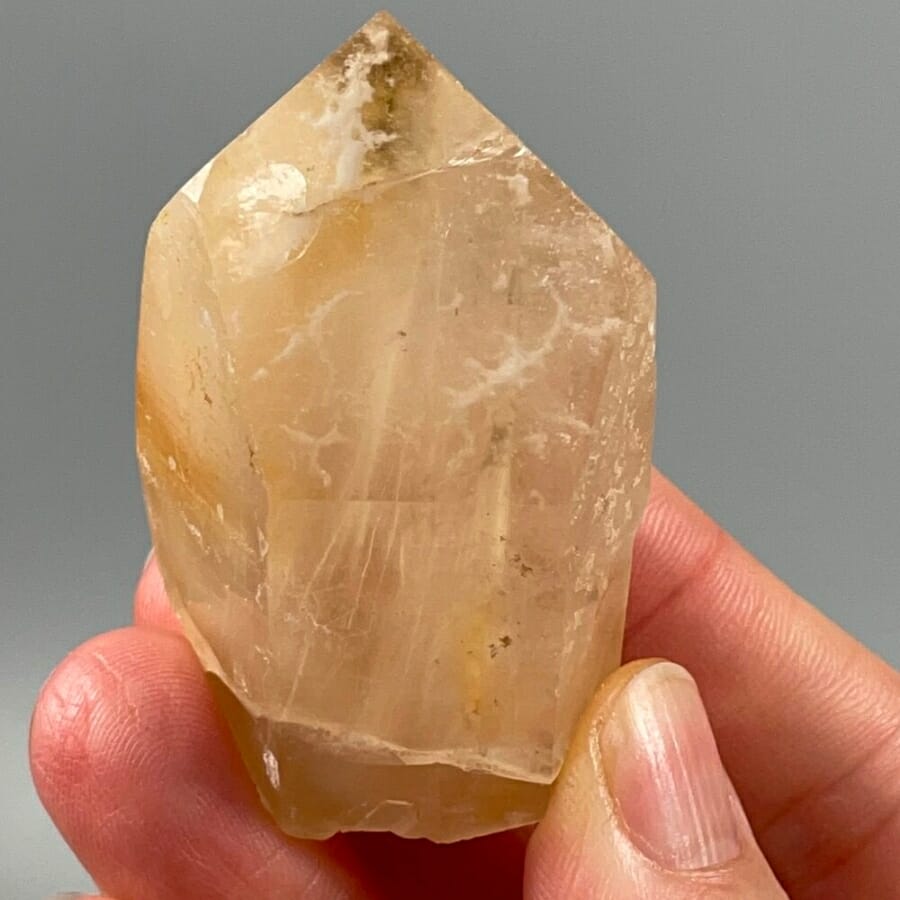
Some minerals form distinct crystal shapes, like the cubic crystals of pyrite or the hexagonal columns of quartz.
Meanwhile, ‘cleavage’ describes how a mineral breaks. Mica, for example, cleaves into thin sheets, while quartz breaks with a conchoidal (shell-like) fracture. Studying these traits can help you successfully identify your specimen.

